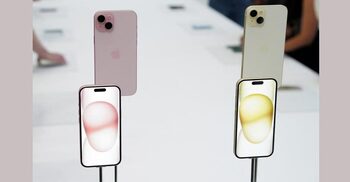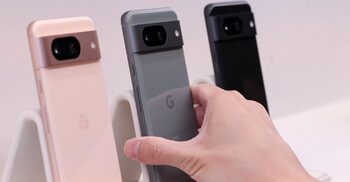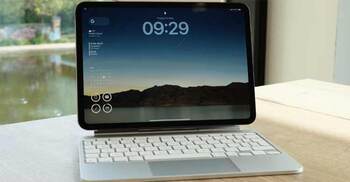Vision Pro review: Apple’s cutting-edge headset lives up to the hype

In a sweltering summer’s day in London, I sat working in the middle of a snow-covered Yosemite national park surrounded by an array of floating apps and browser windows. Later I stared across a windswept Oregon beach reliving a holiday from years ago, and spent an evening sitting in a speeder on Tatooine watching Rogue One in 3D, before retiring for the night with some guided meditation.
These are the sorts of immersive experiences that Apple’s latest, most expensive gadget offers by blending the real and virtual world, all controlled by your eyes and hands. The Vision Pro may resemble virtual reality headsets such as Meta’s Quest series but it is attempting to be so much more.
However, with an extortionate cost of £3,500 (€3,999/$3,499/A$5,999) that most buyers simply wouldn’t consider, this tremendous piece of cutting-edge technology is best thought of as a glimpse of the near future of computing.
Strap on the headset to be transported to a photo-realistic foreign land or seamlessly merge your reality with the virtual by turning the immersion level up or down using the digital crown. The real world is fed through cameras on to pin-sharp displays for passthrough video that is leagues ahead of rivals, clear enough that I could read by phone without taking off the headset.
You view content in floating windows made as big or as small as you want, all anchored in 3D space – walk by them and they stay where they are ready for your return. Simply look at what you want and pinch your fingers together to select it. Type by directly “touching” a hovering keyboard or scroll through sites as you might on a giant virtual iPad.
Take things further by stepping inside an immersive experience to walk with dinosaurs, explore the solar system or fly along a neon-drenched highway in a rhythm game.
Heavyweight tech
The Vision Pro is the absolute pinnacle of headset technology. The same M2 chip as is in the 2022 MacBook Air runs the apps, while its R1 counterpart handles the input from the 12 cameras, five sensors and six mics about the headset. Together they provide a fluid experience, both of the real and virtual worlds, displayed on the two high-resolution micro OLED displays in front of your eyes.
The cameras and sensors on the outside map the real world, including objects such as furniture and walls, tracking your position and the motions of your hands. Internal cameras monitor the movements of your eyes for interacting with buttons and objects, while ensuring that the bit you’re looking at is crisp. The headset even has “Optic ID” instead of Face ID for seamlessly unlocking it and authenticating payments by scanning your iris.
The experience is leaps and bounds better than what has come before, and almost magical at times.
All the technology packed into the Vision Pro creates one of its biggest problems: weight. At up to 650g, it weighs more than Apple’s largest iPad Pro or rival headsets such as the 515g Quest 3. And that 650g doesn’t include the 353g battery, which is attached to the headset by a cord, so you can put it in a pocket or on the desk in front of you.
Your face is scanned with an iPhone during the ordering process to create a custom fit from the roughly 200 combinations of strap size, “light seal” and cushions, which makes it more comfortable than any other headset and means it doesn’t leave goggle marks on your face.
What does linger is the strain on my neck. After a month of wearing the headset daily, I can now manage sessions of up to about two hours. But it still feels as if I’ve done a neck workout, and if I stay too long without decent breaks I get the same neck, shoulder and back ache you get from being hunched over a laptop all day.
The battery lasts for about two to three hours, which is more than long enough since it can easily be charged while being used seated at a desk or on the couch. But the headset is not designed to be easily shared. Even if it does fit guests’ faces, they have to redo the five-minute eye-tracking setup for it to temporarily work.
Productivity use is just scratching the surface
The Vision Pro differs from other headsets because of its full integration into Apple’s ecosystem. It is most like a Mac rather than an iPhone, but one that can spawn an entire environment of apps and productivity anywhere without needing a bunch of monitors.
It has lots of familiar apps, including Apple’s Mail, Messages, Notes, Keynote, Freeform, Photos and others, Microsoft’s Word and Excel, and many more available as “compatibility” apps. Google’s apps such as Gmail and Drive are missing, however, and only some work well as web apps in Safari.
Using the Vision Pro as a productivity setup is great but this really only scratches the surface of what the headset can do.
Apps for the Vision Pro vary wildly. Some simply drag a 2D experience into the headset’s 3D space, like a game played on the screen of a TV placed into your environment. Others are fully immersive environments that can you walk around.
The Apple TV app puts you into a virtual cinema where you can choose your row and seat. Disney+ puts you on a couch in Avengers Tower or sitting in the aforementioned speeder on Tatooine. 3D movies in both services look particularly good.
The Vision Pro is at its peak, however, when combining the real and virtual worlds, such as playing on a virtual chessboard on the table in front of you. Apple’s Encounter Dinosaur demo experience shows what is possible by producing a portal into a prehistoric land that is fixed in a real wall in your room. A butterfly flies out from the portal, landing on your outstretched finger, before a dinosaur enters the view and locks eyes with you, its head and eyes tracking you as you move about the room, before seeing off a rival dino and roaring at you.
There are only a handful of really good experiences available in the App Store for now, but most of the best ones allow direct interaction with your hands and body. While other headsets can perform similar feats, none do it quite as effortlessly, accurately or in as high fidelity as the Vision Pro.
Relive past memories like never before
One of the most unexpectedly wonderful things about the Vision Pro is the way it can help you relive past moments through photos, videos and panoramas.
Loading up a panorama, it genuinely felt as if I was standing in Death Valley again, enjoying the dramatic colours of the sun setting across open desert. Or sitting in a packed Capital One Arena watching the Washington Capitals ice hockey team. A shot from the top of Seattle’s Space Needle even gave me the same uneasy feeling of heights that I had when I captured it seven years ago.
The Vision Pro can also display spatial or 3D videos shot on the headset or with an iPhone 15 Pro. They appear like the small holograms often seen in sci-fi, giving real depth and a sense of being back in the moment, but take some practice to get right when shooting.
Less isolating than other headsets
While wearing the headset is inherently a solo experience, the passthrough of the real world is good enough that you can see and have meaningful conversations with others, even if it is bizarre for them. If you’re in an immersive experience and someone approaches, they appear as a ghostly apparition emerging into your view.
Video calls are oddly good. The headset scans your face to create a digital avatar that is animated by your eye, facial, head and arm movements, to be used in any video chat app or service. Colleagues said it made me look like Rylan Clark in meetings. FaceTime calls with other Vision Pro users are another level, allowing you to see them in 3D space, such as a presentation where the presenter can stand up and point at things as they go.
Sustainability
Apple does not provide an expected lifespan for the battery but it should last in excess of 500 full charge cycles with at least 80% of its original capacity. Additional or replacement batteries cost £199. The Vision Pro is generally repairable. The cover glass costs £749 to replace, while other damage costs £2,259 to repair out of warranty.
The headset contains at least 14% recycled content, including aluminium, gold, tin, textiles, plastic and rare earth elements. Apple breaks down the tablet’s environmental impact in its report and offers trade-in and free recycling schemes, including for non-Apple products.
Price
The Apple Vision Pro costs from £3,499 (€3,999/$3,499/A$5,999).
Prescription lens inserts cost from £99, replacement bands cost £99, light seals cost £199 and cushions cost £25.
For comparison, the Meta Quest 3 costs £480, the Vive XR costs £899 and the Xreal Air Pro 2 costs £449 (requires smartphone).
Verdict
The Vision Pro feels like a massive leap forward, taking what Microsoft, Meta and others have been working on for years and dragging it into the next evolution of mixed reality.
It is packed with cutting-edge technology that fully understands your environment in a way that is totally transparent to the wearer, blending the real and virtual worlds in such a smooth way that it feels almost magical at times. It is something you deliberately go to and put on to work or to experience something, more like a laptop than a smartphone you carry with you all the time. It isn’t a VR headset designed for games such as a Quest 3 but it provides a similar level of escapism.
What is very clear, however, is this is not the device Apple really wanted to make. As good as it is, the endgame is not a heavy headset with a camera feeding a lag-free view of the real world to screens for you to look at, it is a set of glasses through which you can see the actual world with the virtual overlaid.
Instead, the Vision Pro is just the very best that can be made with current technology. An incredible, boundary-pushing device that I’m glad exists. But even as a lover of cutting-edge gadgets, not even I could justify spending £3,500 on one. If you can, I don’t think you will be disappointed.
Pros: next-level immersive and mixed-reality experience, excellent eye tracking and Optic ID, fantastic real-world and hand tracking, familiar apps, iPad “compatibility” apps, no computer required, can import Mac display, fantastic cinema experience.
Cons: extraordinarily expensive, very heavy, battery cable can be annoying at times, as bulky as rivals, no multiple users, hard to share, costly to repair.
Source: The Guardian





